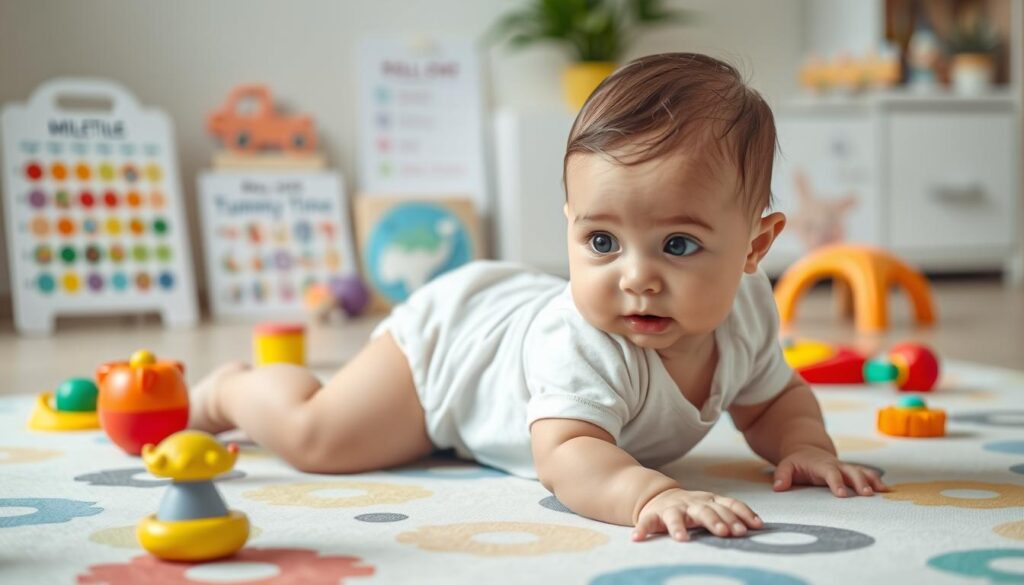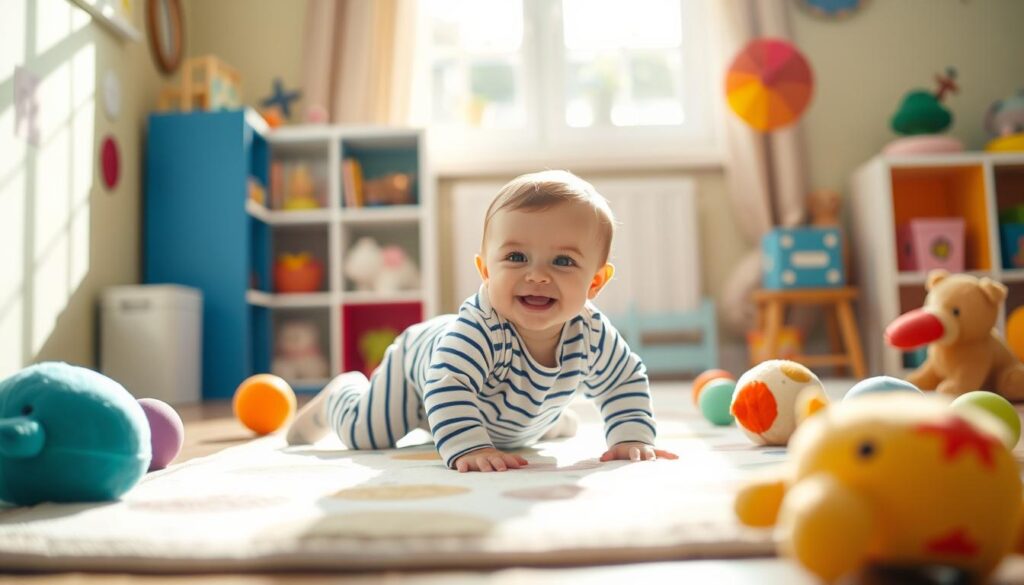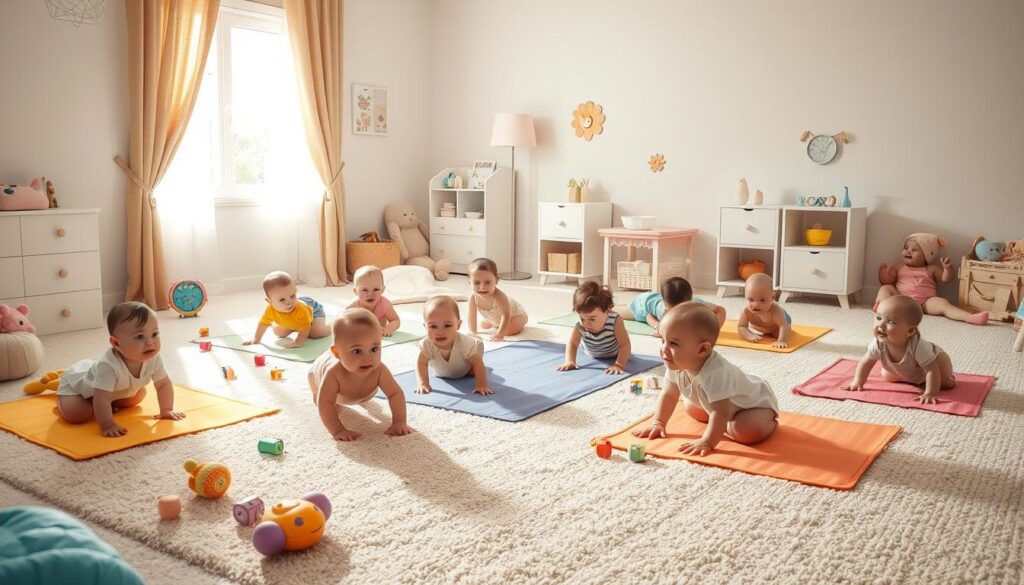As a parent, you’re excited to see your baby start crawling. Knowing when this happens is key to supporting their growth. You might wonder when your baby will crawl and how to help them. Studies show babies usually start crawling between 6 to 10 months.
Knowing when your baby will crawl is important for their motor skills. With the right help, your baby will crawl soon. This article will help you through this exciting time.
Key Takeaways
- Understanding the baby crawling timeline is vital for supporting your baby’s development
- Babies typically start crawling between 6 to 10 months old
- Tracking your baby’s progress is essential for identifying any delays
- Encouraging tummy time and play can help support your baby’s motor development
- Every baby develops at their own pace, so it’s essential to be patient and supportive
- Consulting with your pediatrician can help you stay on track with your baby’s development
- With the right support, your baby will be crawling and exploring their surroundings in no time
The Journey to Mobility: Understanding Baby Crawling
Watching your baby grow is exciting, and seeing them crawl is a big milestone. Crawling is key for future skills like walking and running. Knowing about this journey helps you support your baby’s growth.
Every baby crawls differently, and they may start by rocking or moving their arms and legs. These early signs show they’re working on crawling. It’s a big step for them.
Some important parts of crawling milestones include:
- Improved coordination and balance
- Increased strength in the arms and legs
- Enhanced problem-solving skills
Understanding these aspects helps you support your baby’s growth. Remember, every baby develops at their own pace. Be patient and celebrate each small milestone.
As your baby grows, you’ll see big improvements in their crawling. With time and practice, they’ll become more confident. This sets the stage for a lifetime of exploration and discovery.
When Will My Baby Start Crawling? Typical Timeline
As a parent, you’re eager to know when your baby will start crawling. The baby crawling timeline varies, but most babies start between 6 to 10 months. Some may start as early as 5 months or as late as 11 months. Knowing this timeline helps you prepare and support your baby’s growth.
To understand when your baby will start crawling, let’s look at the typical stages:
- Between 5 to 6 months: Babies start showing interest in moving their arms and legs, and may rock back and forth.
- Between 6 to 7 months: Babies may start crawling, but it’s not always smooth.
- Between 7 to 10 months: Babies usually get better at crawling and move more easily.
Remember, every baby is different, and the baby crawling timeline can vary. If you’re worried about your baby’s development, talk to your pediatrician. Knowing the typical stages helps you support your baby as they reach this exciting milestone.
Physical Signs Your Baby Is Ready to Crawl
Wondering when your baby will start crawling? Look for signs to know they’re getting ready. Head and neck control is key for crawling.
Core strength and arm and leg coordination are also important. These signs help your baby prepare to crawl. Watch how your baby moves and grows to see these signs.
Head and Neck Control
Head and neck control is vital for crawling. It helps your baby stay balanced. Place your baby on their stomach to see if they can hold their head up.
Core Strength Development
Core strength is essential for crawling. It helps your baby keep their posture and move well. Try tummy time activities to help strengthen their core.
Arm and Leg Coordination
Arm and leg coordination is critical for crawling. It lets your baby move their limbs together. Watch how your baby moves their arms and legs on their stomach.

Recognizing these signs helps you support your baby’s crawling journey. Always keep your baby’s safety and development in mind. If you have concerns, talk to your pediatrician.
| Signs of Baby Crawling Readiness | Description |
|---|---|
| Head and Neck Control | Ability to hold head up while on stomach |
| Core Strength Development | Ability to maintain posture and move arms and legs |
| Arm and Leg Coordination | Ability to move arms and legs in a coordinated manner |
Essential Stages Before Crawling
Waiting for your baby to crawl can be exciting. It’s important to know the steps before they crawl. Encouraging baby to crawl needs patience and understanding of these steps. Before crawling, babies go through rolling, creeping, and scooting. These stages are key for crawling and skill development.
Rolling is the first step, where babies move side to side. It builds neck and back muscles for crawling. Then, they creep by moving arms and legs together. Scooting comes next, where babies push forward while sitting.
Creating a safe and stimulating space is vital. Place toys just out of reach to encourage your baby to crawl towards them. This boosts problem-solving and motivation. Understanding these stages and supporting your baby helps them reach crawling milestones.
Remember these tips when encouraging baby to crawl:
- Provide a safe and comfy space for moving.
- Support and encourage as they learn to crawl.
- Be patient and celebrate small victories.
The Role of Tummy Time in Crawling Development
Wondering about tummy time’s role in your baby’s crawling journey? It’s key for building neck and back muscles. Regular tummy time helps your baby get the support they need to crawl.
For tummy time, consider the right positions, how long, and how often. Begin with short sessions, like 2-3 minutes, and increase time as they get used to it.

Optimal Tummy Time Positions
There are best positions for tummy time to help your baby crawl. Place them on a firm, flat surface like a mat. Use toys to keep them engaged and moving.
Duration and Frequency Guidelines
The American Academy of Pediatrics suggests at least 30 minutes of tummy time daily. Start with shorter times and grow it as your baby gets more comfortable.
Making Tummy Time Enjoyable
Make tummy time fun for your baby and yourself. Use playtime to place them on their tummy. Toys and a comfy environment make it enjoyable.
Creating a Safe Environment for Crawling Practice
As you wait for your baby’s baby crawling milestones, setting up a safe space is key. You want your baby to feel free to explore and crawl without fear. A good crawling area is flat, stable, and free from distractions.
To make this happen, follow these tips:
- Choose a flat and stable surface, like a mat or carpet, for a comfy and safe spot for your baby to crawl.
- Take away any breakable or fragile things to avoid accidents and injuries.
- Keep distractions low, like turning off the TV or moving to a quiet room, to help your baby focus on crawling.
By setting up a safe and supportive space, you help your baby reach their baby crawling milestones. Always watch over your baby while they crawl and offer help when they need it.
Here’s a quick rundown of what to focus on for a safe crawling area:
| Element | Description |
|---|---|
| Surface | Flat and stable, such as a mat or carpet |
| Distractions | Minimal, such as turning off the TV or moving to a quiet room |
| Supervision | Always supervise your baby during crawling practice |
Exercises and Activities to Encourage Crawling
As a parent, you want to support your baby’s growth and help them reach milestones. Encouraging your baby to crawl is key. Crawling is important for their physical and mental development. By adding exercises and activities to your daily routine, you can support your baby’s crawling.
Strengthening Exercises
Strengthening exercises help build your baby’s muscles, making crawling easier. Here are some examples:
- Tummy time: Place your baby on their stomach to strengthen their neck and back.
- Leg lifts: Gently lift your baby’s legs to build their core muscles.
- Arm raises: Hold your baby’s arms and raise them to strengthen their shoulders.
Motivational Games and Toys
Motivational games and toys can get your baby moving and crawling. Try placing toys just out of reach to motivate them to crawl.

Parent-Baby Interactive Activities
Interactive activities with your baby can strengthen your bond and support their development. Play games like “peek-a-boo” or “pat-a-cake” to encourage movement and crawling.
By adding these exercises and activities to your daily routine, you can support your baby in reaching the crawling milestone.
| Activity | Benefits |
|---|---|
| Tummy time | Strengthens neck and back muscles |
| Leg lifts | Strengthens core muscles |
| Arm raises | Strengthens shoulder muscles |
Common Crawling Concerns and Solutions
As you watch your baby grow, you might see some crawling worries. It’s key to know when your baby is ready to crawl and handle any problems. Issues like delayed crawling, odd crawling ways, and signs of pain are common.
Some babies crawl differently, which can worry you. But remember, every baby is special, and their crawling can vary. If your baby’s crawling looks off or they seem uncomfortable, talk to a doctor.
To make sure your baby is crawling right, look for these signs of readiness:
- Strong neck and back muscles
- Ability to support their weight on their hands and knees
- Improved coordination and balance
If you’re worried about your baby’s crawling, always talk to a pediatrician. They can give you advice tailored to your baby’s needs.
| Crawling Concern | Solution |
|---|---|
| Delayed crawling | Consult a pediatrician to rule out any underlying medical conditions |
| Abnormal crawling style | Monitor your baby’s progress and consult a pediatrician if you notice any signs of discomfort or pain |
Supporting Your Baby’s Unique Development Path
As you wonder when will my baby start crawling, remember that every baby grows at their own speed. It’s key to support your baby’s unique path to help them reach their best. By understanding and embracing their individuality, you can offer the right support and encouragement for baby crawling milestones.
Here are some ways to support your baby’s growth:
- Provide a safe and stimulating place for them to explore and learn.
- Take part in activities that boost physical and brain growth, like tummy time and playtime.
- Be patient and understanding, as every baby grows at their own pace.

By following these tips and keeping up with your baby’s growth, you can help them hit their baby crawling milestones. This will help them become a happy, healthy, and confident kid. Remember, every baby is different, and it’s vital to support their unique development path.
| Developmental Stage | Characteristics |
|---|---|
| 4-6 months | Baby starts to show interest in crawling, with increased arm and leg movement |
| 7-10 months | Baby begins to crawl, with improved coordination and balance |
Conclusion: Embracing Your Baby’s Crawling Journey
As your baby starts crawling, it’s a big deal. Crawling shows they’re growing physically and learning new things. It’s a key step in their brain, social, and emotional growth. By supporting their crawling, you’re helping them grow strong for the future.
Crawling shows your baby’s determination and growing independence. Every move they make helps them learn important skills. These skills include hand-eye coordination, problem-solving, and understanding space. It’s amazing to see how they grow and learn.
Every baby crawls in their own way and at their own pace. Some might start sooner, while others might try different ways. Your job is to create a safe, fun space for them to explore. This helps them develop skills that will help them achieve more later on.
Enjoy this special time with your baby. Remember, many parents have been where you are. There are lots of resources and support to help you. Embrace this journey and cherish every moment of your baby’s growth.
